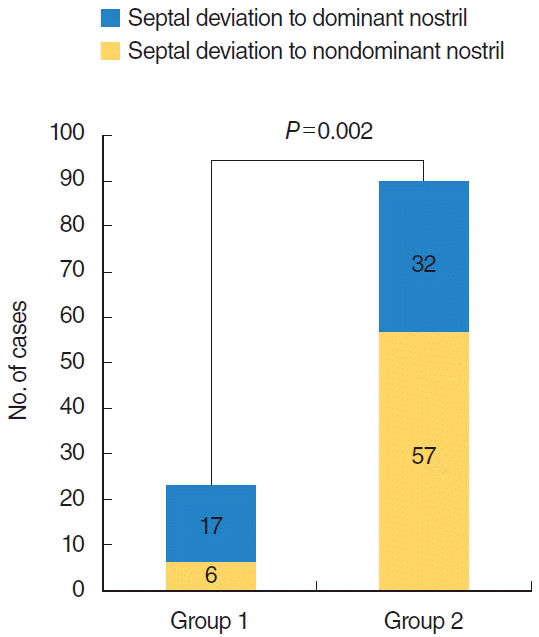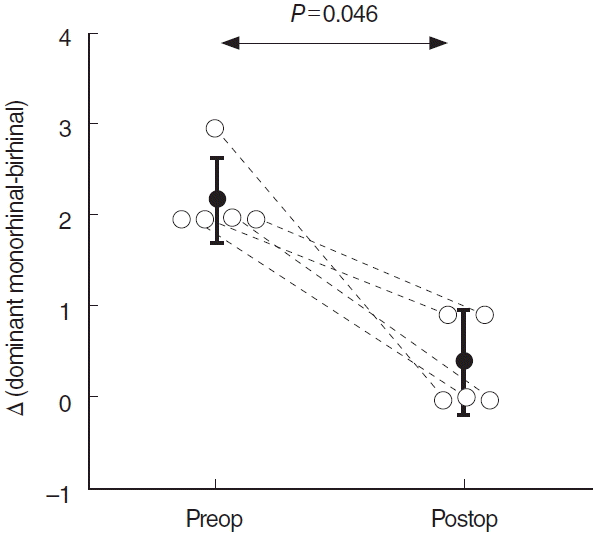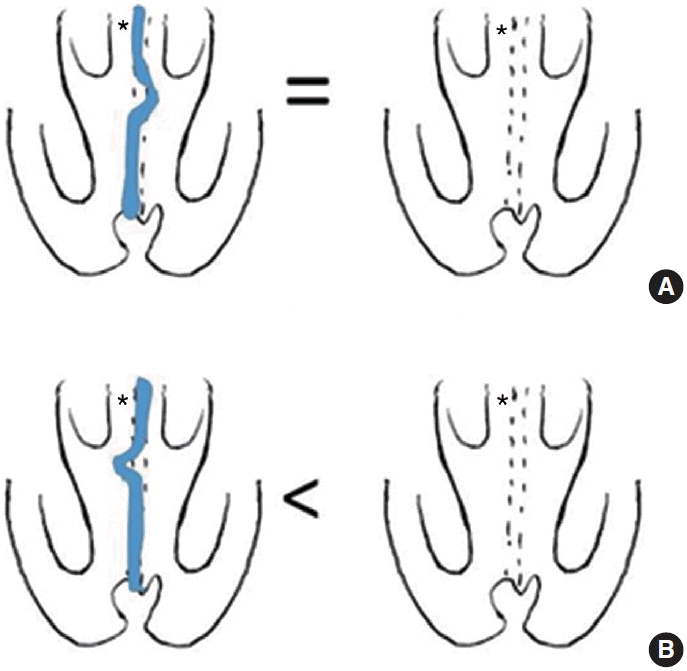Clinical Implications of Septal Deviation in Lateralized Olfaction
Abstract ObjectivesResults of butanol threshold tests (BTTs) have shown that birhinal olfaction tends to converge toward monorhinal olfaction of the dominant nostril. However, birhinal olfaction may also be worse than dominant-side monorhinal olfaction. The goal of our study was to investigate the effect of deviated nasal septum on birhinal olfaction in patients with lateralized olfaction and to examine the effect of septoplasty in these patients.
MethodsA retrospective study with planned data collection was conducted in 518 patients who underwent BTTs. Lateralized olfaction was defined as monorhinal BTT scores that differed by >2 between sides. Underestimated birhinal olfaction was defined as a birhinal BTT score >2 lower than the dominant nostril monorhinal BTT score. Patients with lateralized olfaction were divided into 2 groups: group 1, underestimated birhinal olfaction; and group 2, without underestimated birhinal olfaction.
ResultsAmong 518 patients, 112 with lateralized olfaction were enrolled in this study. Group 1 included 23 patients (20.5%) and group 2 included 89 patients (79.5%). The severity of septal deviation (ratio of the distance of narrower side to wider side) did not differ between the 2 groups. Septal deviation to the dominant nostril was more common in group 1 than group 2 (73.9% vs. 37.6%; P=0.002). Five patients with septal deviation to the dominant nostril with underestimated birhinal olfaction underwent septoplasty. Improved lateralized olfaction occurred in all 5 patients postoperatively (P=0.041).
ConclusionSeptal deviation of the dominant nostril in patients with lateralized olfaction is associated with underestimated birhinal olfaction. Septoplasty may improve olfaction by increasing airflow in the dominant olfactory side.
Keywords: Smell; Nasal Septum; Nasal Cavity; Septoplasty
INTRODUCTION Approximately 15% of the normal population have lateralized olfaction, and this percentage rises to 26%–32% in individuals with chronic rhinosinusitis or a sinonasal tumor [1]. Patients with neuropsychiatric diseases, such as schizophrenia or Parkinson disease, also have significant differences in olfaction between the two sides of their nose [2,3]. Numerous studies have examined the relationship between monorhinal olfaction and birhinal olfaction, but the findings have been contradictory. Differences between monorhinal olfaction and birhinal olfaction have been found to depend on the type of odor. Monorhinal and birhinal olfaction differ for pleasant odors but are similar for unpleasant odors [4]. However, many researchers report that birhinal olfaction offers no significant improvement in olfaction compared to monorhinal olfaction. Birhinal olfaction is mainly influenced by olfaction from the dominant nostril [5-7]. The relative lack of importance of birhinal olfaction differentiates olfaction from acoustic localization or binocular vision, in which the capacity to detect sensory input bilaterally is clearly advantageous over unilateral hearing or vision [7]. Furthermore, authors have commented that olfaction is worse in birhinal olfaction than monorhinal olfaction in a considerable number of patients.In this study, we investigated the effect of deviated nasal septum on birhinal olfaction in patients with lateralized olfaction and examined the effect of septoplasty in these patients.
MATERIALS AND METHODS SubjectsIn this retrospective study, we screened the medical records of 518 patients who underwent butanol threshold tests (BTTs) from November 2012 to October 2013. When a patient smells significantly better with one nostril than with the other nostril, he is said to have lateralized olfaction. In this paper, we defined lateralized olfaction as more than 2 points of BTT scores between 2 nostrils. The better olfaction side was defined as the dominant nostril and the other side was defined as the nondominant nostril.
Patients were included if they had lateralized olfaction. Patients were excluded if they had a history of head trauma, corticosteroid use before the olfactory test, or a recent upper respiratory tract infection. The final study cohort consisted of 112 patients with lateralized olfaction (86 males, 26 females). Their mean age (±standard deviation) was 35.6±14.3 years.
If the birhinal BTT score was lower than the dominant monorhinal BTT score by 2, he or she was said to have underestimated birhinal olfaction. The patients were classified into 2 groups based on their BTT results. Group 1 included patients who had underestimated birhinal olfaction and the remaining patients were assigned to group 2. This study was approved by the Institutional Review Board of Seoul Metropolitan Government-Seoul National University Boramae Medical Center (16-2013-53).
Olfactory function testsOdor threshold testing was performed using the BTT. A series of 10 concentrations of N-butanol (Sigma-Aldrich, St Louis, MO, USA) was generated by serially diluting 4% N-butanol with mineral oil (Sigma-Aldrich). The test was performed in each nostril separately, to evaluate monorhinal olfaction, and in both nostrils simultaneously, to evaluate birhinal olfaction. The study subjects were presented with two polyethylene bottles, one with mineral oil and the other with butanol, and they were asked to choose the bottle with butanol. The test was repeated until the butanol bottle was correctively identified by the examinees in five consecutive trials. The examination was started at a concentration level of 10. The lowest concentration at which the butanol bottle was correctly identified 5 times consecutively was designated as the threshold level.
Eleven patients in group 1 underwent septoplasty. With these patients, BTT tests were conducted 6 months after surgery in 5 individuals who did not have a disease potentially affecting olfaction, such as acute/chronic rhinosinusitis, allergic rhinitis, or a tumor.
Paranasal sinus computed tomographyThe paranasal sinuses, degree of septal deviation, and status of the olfactory cleft were evaluated using paranasal sinus computed tomography. The degree of septal deviation was evaluated quantitatively by measuring the distance from the lateral wall of each nasal cavity to the nasal septum at the most severely deviated point of the nasal septum and calculating the ratio of the distance of narrower side to wider side.
Statistical analysesStatistical analyses were performed with IBM SPSS ver. 18.0 (IBM Co., Armonk, NY, USA). The Mann-Whitney test and Wilcoxon signed rank test were used to determine statistical differences (P<0.05). Data are expressed as the mean±standard deviation.
RESULTS The mean BTT scores for the 112 patients were as follows: dominant monorhinal olfaction, 6.0±1.7; nondominant monorhinal olfaction, 3.1±2.2; and birhinal olfaction, 6.1±1.9. Twenty-three patients (20.5%) made up group 1 and 89 patients (79.5%) made up group 2 (Fig. 1). Septal deviation severity (ratio of the distance of narrower side to wider side) was similar for group 1 (0.56±0.15) and group 2 (0.58±0.19) (P=0.84) on computed tomography (CT) scans. In group 1, CT scans showed that 17 individuals (73.9%) exhibited narrower dominant olfaction side, and 6 (26.1%) had narrower nondominant olfaction side. In group 2, CT scans demonstrated that 32 patients (36.0%) exhibited narrower dominant olfaction side, and 57 (64.0%) had narrower nondominant olfaction side. The percentage of patients with septal deviation of the dominant olfaction side was significantly higher in group 1 than in group 2 (P=0.002) (Fig. 2). Septoplasty was performed in 11 patients in group 1 who had septal deviation of the dominant olfaction side. A postoperative follow-up BTT was performed in five patients who underwent septoplasty. All 5 patients showed corrected septal deviation in postoperative examinations. In addition, all patients exhibited a statistically significant improvement in birhinal BTT scores after surgery compared to before surgery. The mean scores increased from 4.4±1.3 preoperatively to 7.2±1.1 postoperatively (P= 0.038). Also, the difference in BTT scores between birhinal olfaction and dominant side olfaction decreased significantly after surgery: 2.2±0.4 preoperatively vs. 0.4±0.5 postoperatively (P=0.046) (Fig. 3). DISCUSSION Previous studies showed that a deviated septum is associated with functional lateralization of nasal resistance [8], nasal cycle [9], and mucocilliary clearance [10]. In a recent study, septal deviation resulted in decreased olfactory function at the narrower side including odor identification, odor discrimination, and odor thresholds [11]. In odor threshold tests, the difference in mean scores was about 1.7 points. Therefore, in this study, we defined lateralized olfaction as more than 2 points of BTT scores between two nostrils. In this context, septal surgery may improve olfactory function by enhancing transport of odor molecules to the olfactory cleft [12]. However, the sense of smell is not always improved after surgery. Indeed, olfactory function is often compromised after surgery because of direct trauma to, or vascular compromise of, the olfactory epithelium [13]. All nasal surgery may disrupt olfaction, even when it is performed at a distance from the olfactory epithelium [14]. Nevertheless, only a few studies have quantitatively investigated the association between septal surgery and olfaction. As a result, it is exceedingly difficult to predict whether the sense of smell will improve after septal surgery. In this study, lateralized olfaction was observed in 21.6% of 518 patients who visited the clinic with nasal symptoms and who underwent BTTs. Considering the diversity of chief complaints and comorbidities, this percentage is generally comparable to that noted in prior studies: 26% in patients with chronic rhinosinusitis and 32% in those with a sinonasal tumor [5]. As in a previous study, the mean value of birhinal BTT converged to the dominant olfaction side BTT, although it was slightly lower than the dominant olfaction side BTT [7]. This can be explained by the inclusion of patients in whom birhinal olfaction was not superior to monorhinal olfaction. Similarly, our group 1 patients, whose birhinal BTT score was lower than the BTT score of the dominant olfaction side, comprised a substantial percentage of all patients in our study. We hypothesized that septal deviation of the dominant or nondominant olfaction side may influence birhinal olfaction. For patients with deviation of the nondominant olfaction side, the dominant olfaction side BTT score did not differ from the birhinal BTT score (Fig. 4A). However, for those with deviation of the dominant olfaction side, the birhinal BTT score was lower than the monorhinal BTT score of the dominant olfaction side in some cases (Fig. 4B). Septoplasty has become the standard procedure for the treatment of septal deviation. In this technique, the olfactory epithelium may be influenced indirectly through changes in air-flow [13,15]. A computational fluid dynamics experiment demonstrated that a small decrease in nasal valve area (1.45%) resulted in a large decrease in airflow to the olfactory cleft (18.7%) [16]. By contrast, another study of 16 patients awaiting septal surgery has demonstrated no correlation between the volume around the inferior turbinate and olfactory function [17]. In our group 1 patients who underwent surgery, those with septal deviation of the dominant olfaction side exhibited significantly reduced lateralized olfaction after septoplasty. Previously, improved olfaction after septoplasty has been reported by subjective evaluation using a questionnaire [18]. However, subjective evaluation of olfaction may not be reliable. Objective olfactory function testing has been strongly correlated with nasal airway patency in healthy, untrained subjects. It is controversial whether subjective improvement of olfaction is a valid index of objective olfactory function [19-21]. In this study, we found that septoplasty improved birhinal olfaction by reducing lateralized olfaction using objective olfactory function testing before and after surgery. It may be hypothesized that these findings result from changes in intranasal airflow following septoplasty. However, additional studies should be performed with larger sample sizes and control group analyses to further address this issue.Despite some limitations, this study is the first report of the effects of septal deviation on birhinal olfaction. Our results provide valuable information to allow appropriate clinical counseling if olfactory function declines in patients with severe septal deviation.
Septal deviation of the dominant olfaction side is associated with underestimated birhinal olfaction. Septoplasty in these cases may be helpful for correcting the lateralized olfaction. Preoperative monorhinal and birhinal olfactory tests may be useful for appropriate counseling of patients scheduled for septoplasty.
CONFLICT OF INTERESTNo potential conflict of interest relevant to this article was reported.
ACKNOWLEDGMENTSThis study was supported by the Basic Science Research Program through the National Research Foundation of Korea (NRF) funded by the Ministry of Science, ICT and Future Planning (NRF-2014R1A1A1005598).
Fig. 1.Overall flow sheet of olfactory function tests. BTT, butanol threshold test; Group 1, underestimated birhinal olfaction; Group 2, without underestimated birhinal olfaction. *Difference of >2 BTT scores between the two nostrils. †Birhinal olfaction BTT lower than dominant monorhinal olfaction by >2 BTT scores.
 Fig. 2.
Fig. 2.
Septal deviation in groups 1 and 2. Group 1 exhibited a significantly higher percentage of patients with septal deviation of the dominant olfaction side than group 2. Group 1, underestimated birhinal olfaction; Group 2, without underestimated birhinal olfaction.
 Fig. 3.
Fig. 3.
BTT scores before and after septoplasty. The difference in BTT scores between birhinal and dominant side monorhinal olfaction was significantly decreased after surgery. BTT, butanol threshold test; Preop, preoperative; postop, postoperative.
 Fig. 4.
Fig. 4.
Effect of septal deviation on BTT score. (A) For individuals with septal deviation of the nondominant olfaction side, the dominant olfaction side BTT score did not differ from the birhinal BTT score. (B) For those with deviation of the dominant olfaction side, birhinal BTT was lower than the dominant side monorhinal BTT in some cases. BTT, butanol threshold test. *Dominant olfaction side.
 REFERENCES
1. Good KP, Martzke JS, Daoud MA, Kopala LC. Unirhinal norms for the University of Pennsylvania Smell Identification Test. Clin Neuropsychol. 2003 May;17(2):226–34.
REFERENCES
1. Good KP, Martzke JS, Daoud MA, Kopala LC. Unirhinal norms for the University of Pennsylvania Smell Identification Test. Clin Neuropsychol. 2003 May;17(2):226–34. 








 Share:
Share:  METRICS
METRICS 
留言 (0)